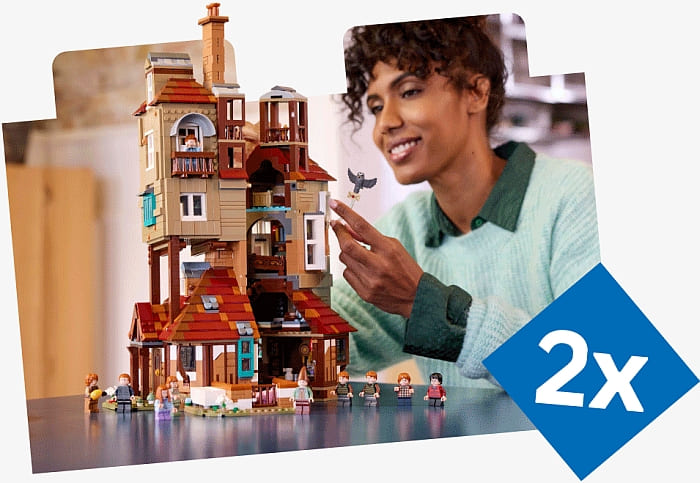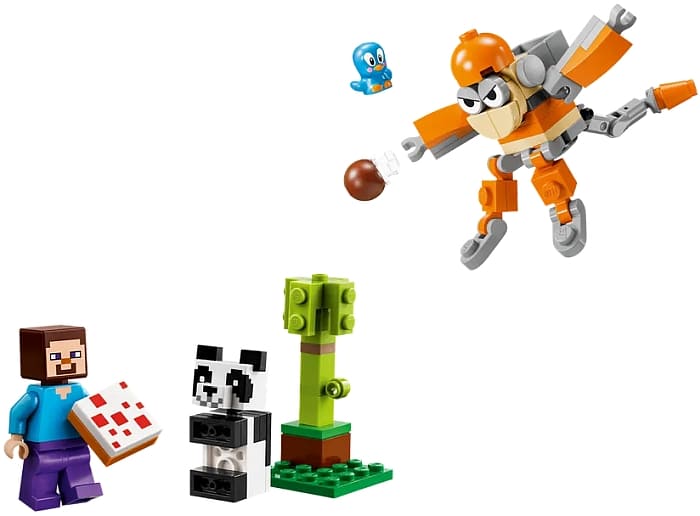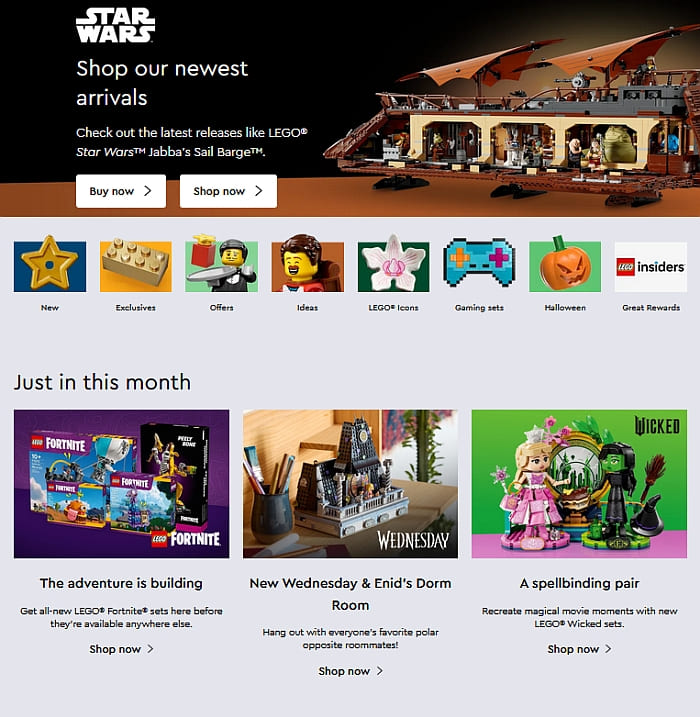(Written by William)
When LEGO offered the #76780 LEGO Wednesday Addams Figure for review, we were given two pieces of information. First, we knew what the set number was. Second, we knew it had the code name “Buffalo”. Thanks to rumors, I guessed that it was most likely one of the Wednesday sets, and I was very interested in checking it out.
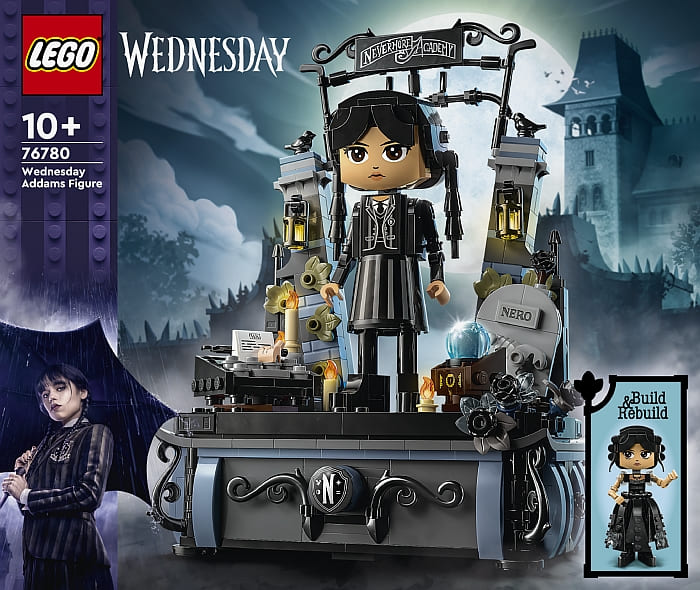
As a quick aside, the code name might come from the old black-and-white Addams family TV series. I actually watched it in its entirety before moving to more recent Addams family content and ending with Wednesday. I don’t recommend watching the original show, however, it’s interesting to note that in it there are something like three different origin stories for how Wednesday’s parents met. One involves her mom riding a buffalo. I have no idea if that is where the code name comes from, but it seems like an odd coincidence.
Back to the set and the show it is based on. The design features a Wednesday figure, which is scaled up about three times in size to a mini-doll. The overall proportions look to simulate a mini-doll’s shape. I am not a huge fan of mini-dolls, but I kind of like the look when made at this size.
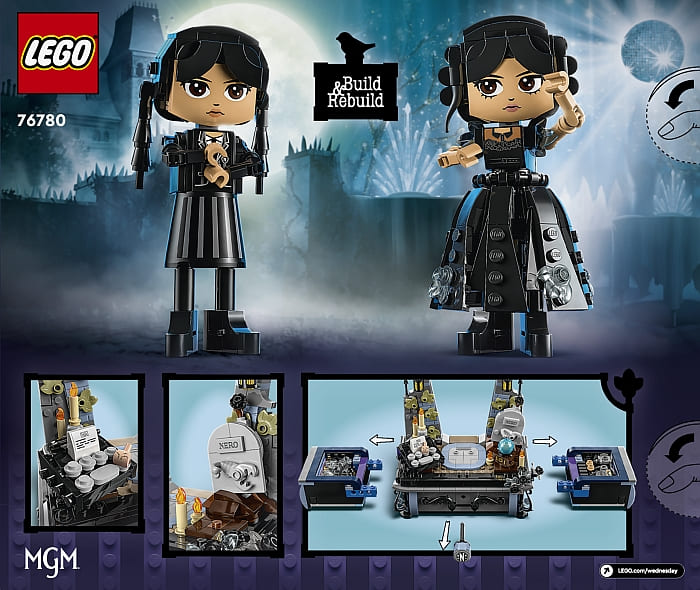
The figure is surrounded by objects present in the show including a typewriter, crystal ball, grave, and front gate of the Nevermore Academy. All of this is built on a beautifully designed platform containing two drawers which are locked in place with an axle. These drawers are used to hold extra parts for Wednesday’s second outfit and hairstyle.
This is probably all the basic info you can get just by reading the set’s description. So, let’s dig a little deeper to see what this set offers and figure out who might like it the most. Spoiler alert, I know I’m part of the crowd who I think it is for.
LEGO WEDNESDAY – TO PLAY IS TO POSE & BUILD
Unlike LEGO’s constructible action figures (also referred to as Constraction Figures) Wednesday is built more for posing rather than playing with directly. She has a number of elements – no matter which outfit she is in – that can easily come apart. However, I wouldn’t say this set lacks play potential.
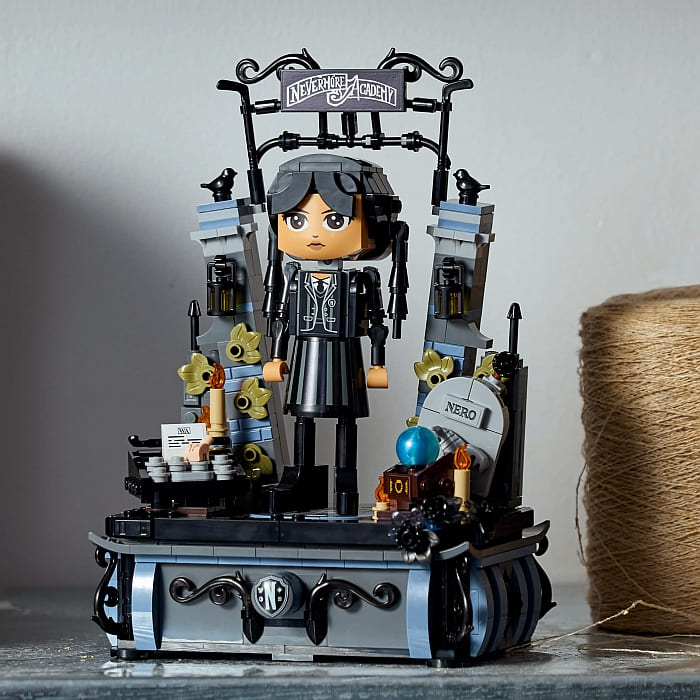
The core of this model is what it offers in terms of building experience. The method by which the drawers come together feels fresh yet not too complex. The pillars that hold the wrought iron sign have a clever tilt to them, and the wrought iron itself is exquisitely designed. Don’t get me wrong, the sign is still very fragile, but boy does it look slick. These are all pretty much one-time builds, so you’d think the play is limited, but that’s where the figure comes in.
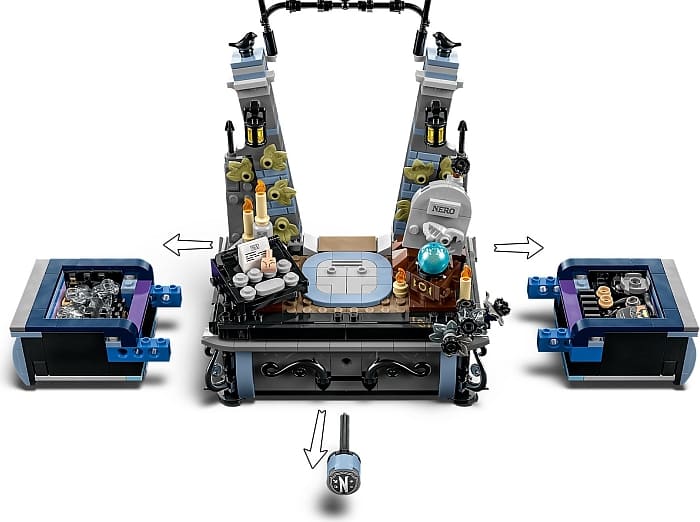
Wednesday comes with the parts to make two distinct looks. The first is her school uniform. The second is the more elaborate dress she wore for the Raven’s dance. The set fully expects you to change her up between these two designs.
One of the stickers that came with the set is a QR code you are meant to place at the back of the platform. Since I was building an early preview copy, it didn’t work as intended. It did take me to the digital building app though. Based on what it hinted at in the instructions, this might be the instructions you need to change from the uniform to dress and back more easily. The printed instructions would have you break down quite a bit of the model before rebuilding.
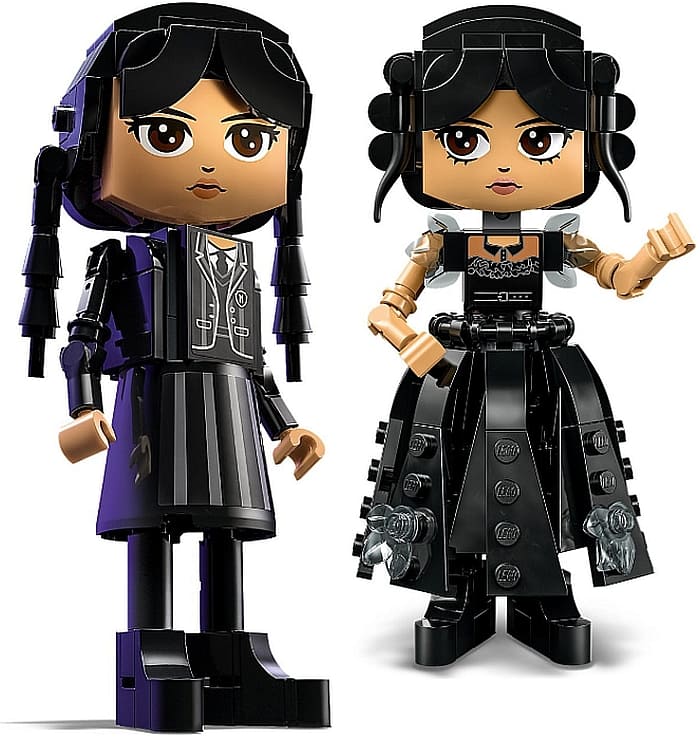
Looking over the parts, I can imagine builders experimenting with her hairstyle. Additionally, the model comes with two facial expressions that you can mix and match as well. Couple this with a ball-joint at her neck to pose her head, each arm with two points of articulation. One point is at her shoulder, which can rotate and hinge, and the second is at her elbow, which just can hinge. And you have a pretty expressive sculpture to rebuild. I should mention that each leg can rotate so her toes can point in different directions, but that’s about it. Don’t expect much from her lower body.
As with other buildable figures in recent years, priority is given to making the character look good and not necessarily play well. However, unlike other buildable figures, Wednesday has a build component to her that seems a bit more novel. The closest rebuildable figure I can think of is the #76297 LEGO Marvel Dancing Groot with his various accessories. Still, Wednesday requires a bit more skill and effort in the rebuild, which is a nice way to maintain a method to play with the model.
LEGO WEDNESDAY – PARTS & STICKERS
From the pictures, it’s obvious there are some extra graphics in this model. But which ones are stickers and which are printed? Sadly, most of what you see are stickers. The Nevermore sign, the QR code in the back, the paper coming out of the typewriter, the etching on the tombstone, and the plaque on the crystal ball are all stickers. Even the tile and slope that decorate Wednesday’s two torsos are stickers. The only printing we get are the two faces for her as well as the 2×2 rounded boat slide that has the crest on the front of the platform, and a stone skull printed on a minifigure head. So, if you’re after printed elements this might not be what you want to hear.
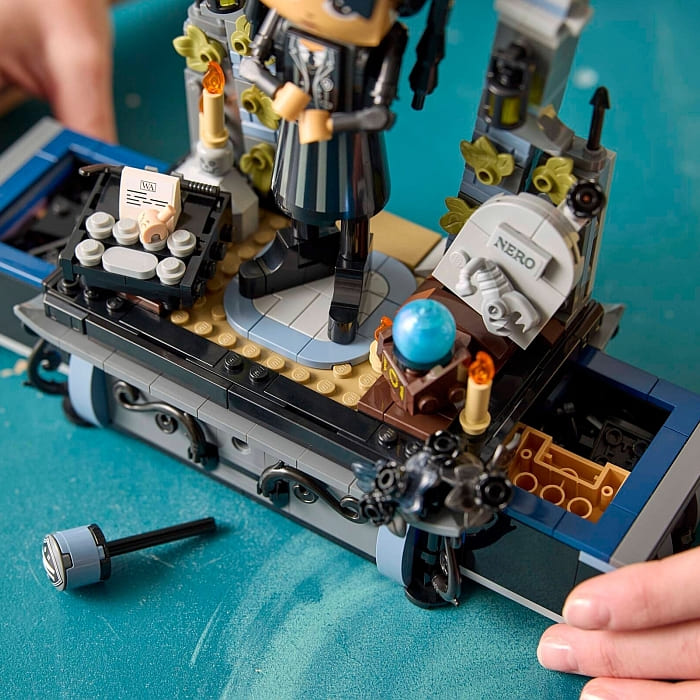
Avid builders are going to want to give this set a close look because of the parts selection. Given the dark subject matter, it’s wise to expect a lot of black elements. A new flower mold in black is used quite heavily in the model, Additionally, the wrought iron designs feature the curling accent pieces, hockey sticks, harpoons, hotdogs, among various tubing, staff hilts, and even two small birds all in black. Then there are the plate leaves. We get those in a silver metal color as well as in translucent-black.
As for new moulds only three stuck out to me. The first of these is Wednesday’s two faces. They are a thick chunky slope with fairly unique shaping and curves. Due to the printing on them, this might relegate them to only being faces for other buildable characters. Next is the slope for her school uniform. This is a tall cone shape that narrows to a 2×2 stud at its top and flares out to more of a 4×4 at its bottom. The interesting thing is for the most part the piece is hollow. This can allow you to hide some interesting little surprises. However, the set will have you place a sticker on this piece so that may limit what you do with it.
The last interesting piece can be found at the four corners of the platform right above each curly accent. This element is like a 2×2 plate. However, it only has one stud in one corner. And the corner that is opposite it is tilted up raising it up a plate high. This tilt forms an interesting sloped shape that kind of resembles a pleat in clothing.
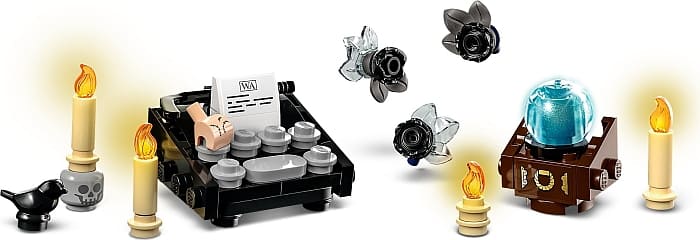
There is also another piece that I really should bring up, but I’m terrible about seeing past what it is. That part in question is the new Thing mould. It takes up the same amount of space as a LEGO frog. However, it has some unique properties. The fingers can fit around and grasp a stud. So it can be properly positioned and built onto surfaces. Between the fingers, it looks like it can hold a bar, but it can’t. Additionally, Thing’s wrist is the size of a bar so you can stick Thing’s wrist into a hollow stud. Frankly, Thing would make an excellent hand for a buildable zombie character made to the same scale as Wednesday. The problem for me is that there is printing on Thing and you only get one in the set. Plus, I found the clutch-power of the fingers to be rather weak.
Beyond these special elements, the color-palette of the set is a neutral dark mix of colors. This means grays, browns, and blacks dominate. Thankfully these are all fairly neutral colors, which can be sometimes easier to use in creations compared to their more colorful counterparts. All in all, this gets high marks as a parts pack.
LEGO WEDNESDAY – FINAL THOUGHTS
At a $50 MSRP, this set is in line with the pricing of other buildable figures. Iron Man, the Buildable Minifigure, and Groot all were around this price and all offered something that looked great to display. With that said, I like the build-and-rebuild play feature that Wednesday presents. She offers a nice intermediate level of complexity when it comes to building as well. A novice won’t feel out of their depth and a seasoned builder will still be entertained.
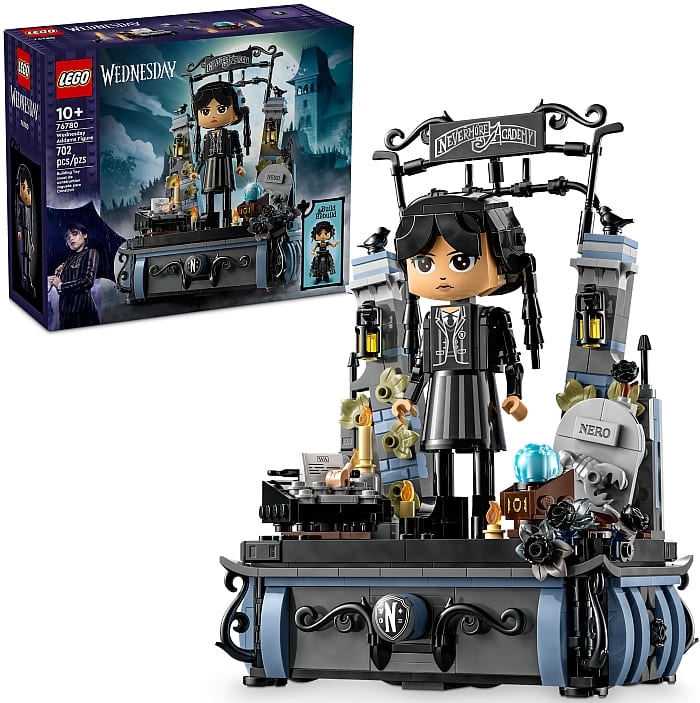
If I had anything to complain about it would probably be the number of stickers needed. I understand the cost savings, but allowing me to mess up my own model due to poor sticker placement is never fun.
As for what surprised me, it was the quality of the build. I was entertained whether it was the functionality of the drawers and how they locked, to the mini builds that made up the decorations, and especially the wrought iron work. But what caught me off guard is how much I liked the style of the figure. If I think about it, I can see that it was an enlarged mini-doll, but it’s also something I can easily ignore.
Considering the source material, the Addams family is meant to have a slightly disturbing quality about it. The super thin arms kind of remind me of Tim Burton’s work, which meshes well with the Addams family. However, this is all tempered with the stylish cute aesthetics found in mini-dolls. The end result is something uniquely its own thing just like the Wednesday show. In the video below, I talk about the set in a bit more detail.
So, who is this set for? I’d say fans of Wednesday would get a kick out of this set and not be at a loss putting it together. Fans of mini-dolls can get inspired to maybe bring their other dolls to life in this scale. Seeing how it comes together will help with that. Those looking for interesting parts will find some cool pieces here. Builders will enjoy themselves with a couple of interesting part usage. In fact, the only group this might not be for is the younger builders. This model has quite a bit of delicate designs which would most likely lead to breakage and frustration.
In conclusion, this is a well-priced set. It is fun to build and rebuild. I love the end result including a storage solution for extra pieces. And despite my reservations about mini-dolls, it won me over. If you’re interested, you can check it out at the LEGO Wednesday section of the Online LEGO Shop.
What do you think? How do you like the new LEGO Wednesday sets? And what do you think of the upscaled mini-doll figure? Feel free to share your thoughts and own reviews in the comment section below!
And you might also like to check out the following related posts:


